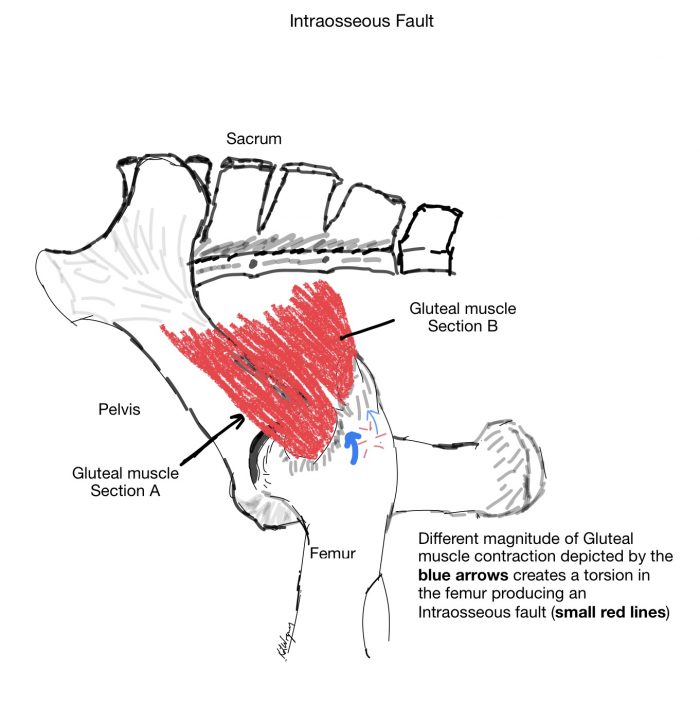Intraosseous faults (IOF) are painful changes on the surface of the bone. Bone has a membrane structure like cellophane wrapped around it. This membrane is called the periosteum. The periosteum has a large amount of nerve endings in it. Pain originates from the periosteum in damaged or fractured bone.
Intraosseous faults are not addressed by most chiropractors as they perform basic chiropractic manipulations. If most chiropractors don’t address them why are they important? When intraosseous faults are cleared in humans, the patients complain how painful the faults are when corrected. The horse illustrates a similar reaction when they move away during the treatment and act relaxed and relieved after the correction. The pain produced by them warrants the need for correction.
As the muscles contract, they pull on the bones to move the horse. When the muscles contraction is balanced, even and in the proper biomechanical motion, the bone moves in a normal fashion. But what happens if the muscle is fatigued, or the horse takes a bad step or slips, or if the horse has improper biomechanics, abnormal bone motion occurs. Live bone is malleable or bendable. If this abnormal bone motion produces a torsion or twisting of the bone (as depicted by the blue arrows), a small electrical charge (as depicted by the small red lines) is produced in the bone matrix just below the periosteum. This electrical charge is large enough to cause stimulation of periosteal nerves. The horse perceives a pain response on the bone surface.
 The pain stimulus initiates a couple of responses in the nervous system of the horse. The horse changes their biomechanics of movement so the pain is not perceived. This would be similar to you stubbing your toe. You change the way you walk so you don’t perceive your toe hurting. But if you reach down and touch your toe it still hurts. Also affecting the biomechanics, the IOF can create Central Pattern Generator dysfunction. With the CPG dysfunction, the CPG’s indicator muscle becomes weak allowing laxity and micro-trauma to occur in the joints resulting in arthritis and degenerative joint disease. Biomechanical function change has a compounding effect. With one CPG deficit, the abnormal biomechanics of gait for the horse has a domino effect causing other CPG deficits. As the CPG deficits increase, soreness and damage accumulate in muscles, ligaments, tendons and joints creating traditional lameness problems.
The pain stimulus initiates a couple of responses in the nervous system of the horse. The horse changes their biomechanics of movement so the pain is not perceived. This would be similar to you stubbing your toe. You change the way you walk so you don’t perceive your toe hurting. But if you reach down and touch your toe it still hurts. Also affecting the biomechanics, the IOF can create Central Pattern Generator dysfunction. With the CPG dysfunction, the CPG’s indicator muscle becomes weak allowing laxity and micro-trauma to occur in the joints resulting in arthritis and degenerative joint disease. Biomechanical function change has a compounding effect. With one CPG deficit, the abnormal biomechanics of gait for the horse has a domino effect causing other CPG deficits. As the CPG deficits increase, soreness and damage accumulate in muscles, ligaments, tendons and joints creating traditional lameness problems.
IOF pain becomes subconscious pain. Since the horse changes his biomechanics, the area of the bone that contains the IOF is not strained to initiate the pain response. For instance, with IOF’s in the sacrum and wing of the pelvis, the sacroiliac joint, the joint between the pelvis and spine or SI joint motion is restricted. The SI joint restricted motion reduces the pain stimuli of the IOF. The basic chiropractor will motion test the SI joint and find restricted motion. The chiropractor will adjust the SI joint improving or restoring the SI joint motion. But since the IOF pain stimuli has not been corrected, about 24 – 48 hours after the basic chiropractor’s adjustment the restricted SI motion returns. The horse is than back in the same condition as before the adjustment. All factors influencing the restricted SI motion need to be corrected to return the horse back to proper biomechanical motion.
In conclusion, a common bone pathology, an intraosseous fault at the surface of the bone produces significant biomechanical alterations in the horse’s gait. If left untreated, the IOF produced CPG deficits cause abnormal biomechanical gait function resulting in sore or damaged musculoskeletal structures of the horse. This concept is why a large percentage of lameness in horses can be prevented or significantly reduced. Improved treatment protocols need to be initiated sooner to maintain soundness in our equine athletes. Owner’s or trainer’s recognition of the change in the horse’s movement is key to initiating these improved treatment protocols. A loss in the horse’s rhythmic movement or reduction of free bending of the spine are indications a problem is developing.
